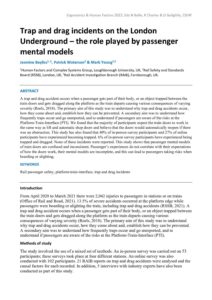| Document | Author Jasmine Bayliss, Patrick Waterson & Mark Young |
| Abstract A trap and drag accident occurs when a passenger gets part of their body, or an object trapped between the train doors and gets dragged along the platform as the train departs causing various consequences of varying severity (Roels, 2018). The primary aim of this study was to understand why trap and drag accidents occur, how they come about and, establish how they can be prevented. A secondary aim was to understand how frequently traps occur and go unreported, and to understand if passengers are aware of the risks at the Platform-Train-Interface (PTI). We found that the majority of participants expect the train doors to work in the same way as lift and automatic shop doors and believe that the doors would automatically reopen if there was an obstruction. This study has also found that 40% of in-person survey participants and 27% of online participants have experienced becoming trapped. 6% of in-person survey participants have experienced being trapped and dragged. None of these incidents were reported. This study shows that passenger mental models of train doors are confused and inconsistent. Passenger’s experiences do not correlate with their expectations of how the doors work, their mental models are incomplete, and this can lead to passengers taking risks when boarding or alighting. |

